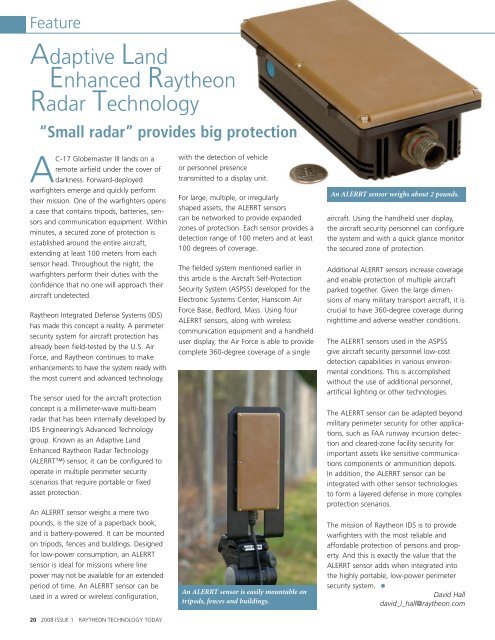Technology Today issue 1 2008 - Raytheon
Technology Today issue 1 2008 - Raytheon
Technology Today issue 1 2008 - Raytheon
Create successful ePaper yourself
Turn your PDF publications into a flip-book with our unique Google optimized e-Paper software.
Feature<br />
Adaptive Land<br />
Enhanced <strong>Raytheon</strong><br />
Radar <strong>Technology</strong><br />
“Small radar” provides big protection<br />
AC-17 Globemaster III lands on a<br />
remote airfield under the cover of<br />
darkness. Forward-deployed<br />
warfighters emerge and quickly perform<br />
their mission. One of the warfighters opens<br />
a case that contains tripods, batteries, sensors<br />
and communication equipment. Within<br />
minutes, a secured zone of protection is<br />
established around the entire aircraft,<br />
extending at least 100 meters from each<br />
sensor head. Throughout the night, the<br />
warfighters perform their duties with the<br />
confidence that no one will approach their<br />
aircraft undetected.<br />
<strong>Raytheon</strong> Integrated Defense Systems (IDS)<br />
has made this concept a reality. A perimeter<br />
security system for aircraft protection has<br />
already been field-tested by the U.S. Air<br />
Force, and <strong>Raytheon</strong> continues to make<br />
enhancements to have the system ready with<br />
the most current and advanced technology.<br />
The sensor used for the aircraft protection<br />
concept is a millimeter-wave multi-beam<br />
radar that has been internally developed by<br />
IDS Engineering’s Advanced <strong>Technology</strong><br />
group. Known as an Adaptive Land<br />
Enhanced <strong>Raytheon</strong> Radar <strong>Technology</strong><br />
(ALERRT) sensor, it can be configured to<br />
operate in multiple perimeter security<br />
scenarios that require portable or fixed<br />
asset protection.<br />
An ALERRT sensor weighs a mere two<br />
pounds, is the size of a paperback book,<br />
and is battery-powered. It can be mounted<br />
on tripods, fences and buildings. Designed<br />
for low-power consumption, an ALERRT<br />
sensor is ideal for missions where line<br />
power may not be available for an extended<br />
period of time. An ALERRT sensor can be<br />
used in a wired or wireless configuration,<br />
20 <strong>2008</strong> ISSUE 1 RAYTHEON TECHNOLOGY TODAY<br />
with the detection of vehicle<br />
or personnel presence<br />
transmitted to a display unit.<br />
For large, multiple, or irregularly<br />
shaped assets, the ALERRT sensors<br />
can be networked to provide expanded<br />
zones of protection. Each sensor provides a<br />
detection range of 100 meters and at least<br />
100 degrees of coverage.<br />
The fielded system mentioned earlier in<br />
this article is the Aircraft Self-Protection<br />
Security System (ASPSS) developed for the<br />
Electronic Systems Center, Hanscom Air<br />
Force Base, Bedford, Mass. Using four<br />
ALERRT sensors, along with wireless<br />
communication equipment and a handheld<br />
user display, the Air Force is able to provide<br />
complete 360-degree coverage of a single<br />
An ALERRT sensor is easily mountable on<br />
tripods, fences and buildings.<br />
An ALERRT sensor weighs about 2 pounds.<br />
aircraft. Using the handheld user display,<br />
the aircraft security personnel can configure<br />
the system and with a quick glance monitor<br />
the secured zone of protection.<br />
Additional ALERRT sensors increase coverage<br />
and enable protection of multiple aircraft<br />
parked together. Given the large dimensions<br />
of many military transport aircraft, it is<br />
crucial to have 360-degree coverage during<br />
nighttime and adverse weather conditions.<br />
The ALERRT sensors used in the ASPSS<br />
give aircraft security personnel low-cost<br />
detection capabilities in various environmental<br />
conditions. This is accomplished<br />
without the use of additional personnel,<br />
artificial lighting or other technologies.<br />
The ALERRT sensor can be adapted beyond<br />
military perimeter security for other applications,<br />
such as FAA runway incursion detection<br />
and cleared-zone facility security for<br />
important assets like sensitive communications<br />
components or ammunition depots.<br />
In addition, the ALERRT sensor can be<br />
integrated with other sensor technologies<br />
to form a layered defense in more complex<br />
protection scenarios.<br />
The mission of <strong>Raytheon</strong> IDS is to provide<br />
warfighters with the most reliable and<br />
affordable protection of persons and property.<br />
And this is exactly the value that the<br />
ALERRT sensor adds when integrated into<br />
the highly portable, low-power perimeter<br />
security system.<br />
David Hall<br />
david_l_hall@raytheon.com

















